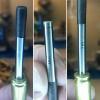Nature Boy
Member
- Joined
- Apr 21, 2015
- Messages
- 8,228
I want to get some feedback once more before I toss some Lapua brass
308 fired 8 times
The pin gage goes into the pocket on the left case as far as I have marked on the picture in the middle. The case on the right doesn't go in nearly that far.

Sorting 200. So far I'm having about 50% like the case on the left
308 fired 8 times
The pin gage goes into the pocket on the left case as far as I have marked on the picture in the middle. The case on the right doesn't go in nearly that far.

Sorting 200. So far I'm having about 50% like the case on the left

